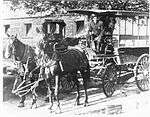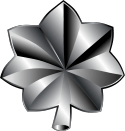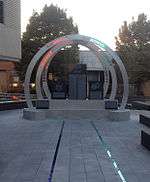Oklahoma City Police Department
| Oklahoma City Police Department | |
|---|---|
| Abbreviation | OCPD or OKC PD |
|
Patch of the Oklahoma City Police Department | |
|
Badge of the Oklahoma City Police Department | |
|
Flag of the Oklahoma City Police Department | |
| Motto |
Officium Integritas Honestas (English: "Duty, Integrity, Honor") |
| Agency overview | |
| Formed | 1889 |
| Annual budget | $100 million annually |
| Legal personality | Governmental: Government agency |
| Jurisdictional structure | |
| Operations jurisdiction* | City of Oklahoma City in the state of Oklahoma, USA |
|
| |
| Map of Oklahoma City Police Department's jurisdiction. | |
| Size | 621.2 square miles (1,609 km2) |
| Population | 610,513 (2012) |
| Legal jurisdiction | Sate law and municipal ordnance |
| General nature | |
| Operational structure | |
| Headquarters | Oklahoma City, Oklahoma |
| Police Officers | 1,169[1] |
| Civilians | 300+ |
| Agency executive | William "Bill" Citty, Chief of Police |
| Facilities | |
| Stations | 10 |
| Airbases | 1 |
| Boats | 2 |
| Helicopters | 2 |
| German Shepherds | 9 |
| Website | |
|
www | |
| Footnotes | |
| * Divisional agency: Division of the country, over which the agency has usual operational jurisdiction. | |
The Oklahoma City Police Department (OCPD or OKC PD), was established in 1898 following the Land Runs. The OCPD is the largest law enforcement agency in the State of Oklahoma and has primary police jurisdiction within the corporate limits of the City of Oklahoma City. The OCPD is one of the oldest police departments in Oklahoma, tracing its roots back to Indian Territory.
Specialized services which are part of the OCPD include the Tactical Team, K9, lake patrol, police aviation, bomb squad, counter-terrorism, criminal intelligence, anti-gang, narcotics, and airport police. The OCPD is accredited by the Commission on Accreditation for Law Enforcement Agencies.
The OCPD has a crime scene investigation service and full crime laboratory, as well as units which assist with electronic and computer crime investigations. In 2015, there were 1,169 sworn officers and 300 civilians employees serving in the department.
History
Formation

The Oklahoma City Police Department was officially formed following the Land Rush of 1889 in central Indian Terroity.[2] The department began as a small collection of officers. The department's first Chief was Charles F. Colcord and municipal court was held in a small tent near California Avenue.[2] By the turn of the century, public drinking had caused many quality of life issues for the small community.[3] In 1907, Oklahoma voters approved a liquor prohibition.[4] A new City Charter was adopted early in March 1911. One of the Charter's provisions changed the office of the Chief of Police from elective to appointive. The charter also adopted a commissioner form of government.[2] In July 1911, Mayor Whit Grant named Bill Tilghman as police chief.[2] Tilghman had earned a reputation in the Western frontier having served as a U.S. Marshal, where tracked down outlaws like Bill Doolin.[2] Under Tilgham's leadership, the OCPD rigorously targeted gambling, bootlegging, and prostitution rings.[3]
World War I & Post War

During the war, the OCPD established a Traffic Department and motorcycle squad.[3] The department also implemented an electric callbox system city wide.[2] Officers walking a beat were required report with police dispatch by pushing "6-1" on the callbox.[2] By 1923, the OCPD had expanded from 90 officers to 150.[3] Additionally, the department created a mounted patrol unit, which began patrolling residential districts and directing traffic.[2] In 1927, the city adopted a city manager form of government, in an effort to make city services non-partisan.[2] In 1928, the OCPD created training courses for officers. Newly hired officers were required to complete the courses.[2]
Great Depression era
America's gangster era ushered in a new paradigm for the OCPD. The crime wave of the Great Depression forced the OCPD to begin a transition from a lose collection of untrained men, towards a professionalized force. During the Thirties, nine officers were killed in the line of duty.[2] The OCPD began created a "Radio Patrol Unit" and began installing mobile radios in police cars, which greatly improved the safety and efficiency of officers.[3]

Perhaps one of the most department's most interesting lawmen emerged during this time. D.A. "Jelly" Bryce, joined the OCPD in 1928.[3] Known for his draper appearance, he earned the nickname "Jelly" from fellow officers.[5] By the early 1930s, Bryce was promoted to the department's "Raiding Squad" as a plain clothes detective.[5] In the unit, Bryce recovered dozens of stolen cars, and broke-up numerous bootlegging outfits and gambling rackets.[5][6] Bryce was renown for his ability to track down outlaws and gangsters, most notably, Wilbur Underhill.[4][5] Bryce often carried a shotgun and Thompson sub-machine gun while on duty.[5] During his law enforcement career, Bryce was involved in 19 gun battles and killed at least 17 men.[5] However, the exact number is unknown due to poor record keeping at the time.[5] Bryce was known for his quick draw and was featured in LIFE magazine.[5] He was electronically timed at two-fifths of a second to draw and accurately fire.[5] It was reported at the time that "if a crimminal blinked at Jelly Bryce, he would die in darkness."[5] Bryce left the OCPD and later became an FBI Special Agent in Charge, before running unsuccessfully for Governor of Oklahoma.[4]
World War II & Post War

Throughout the World War II, the department suffered from a severe shortage of manpower.[2] As a result, the requirements to become a police officer were relaxed and many clerical positions were filled by civilians.[3]
Following the war, the OCPD began a move towards specialization and professionalization. The department created a training unit.[2] The unit conducted a 144-hour training course for new recruits.[2] The department began new investigation units, such as burglary, traffic accident, white collar crime, and fingerprint collection.[3]
1960s
During the early 1960s, the OCPD established a K-9 unit, a forensics laboratory, and a police academy.[2] In 1965, the OCPD headquarters building at 701 Colcord Avenue was completed.[3] In 1969, the OCPD began issuing sidearms to officers.[2] The department issued officers S&W Model .38 Specials.[2] In the years prior, officers had been required to purchase their own weapons.
1970s
In the Seventies, the OCPD began the Alcohol Safety Action Project (ASAP) designed to reduce drunk driving.[2] The department also created a Selected Enforcement Unit, designed to reduce crime in problomatic areas.[2] The OCPD also added a police helicopter and Tactical Team (SWAT).[2] In 1974, Shirley Cox became the first female OCPD officer.[2] In the fall of 1975, OCPD officers went on a work slowdown to protest low wages.[2] On October 24, nearly all 600 OCPD officers walked into City Hall and placed their badges on the city council's conference table.[2] Over the next three days, the Oklahoma County Sheriff Office and the Oklahoma Highway Patrol provided police service to the city.[2] Finally, on October 27, a settlement was reached, which resulted in a pay increase and added benefits for officers.[2][2]
1980s
In the 1980s the city's population rapid grew, and so did crime rates.[2] The department implemented new equipment, such a mobile CSI unit, forensic training for patrol officers, and a field training program (FTO).[7]
1990s

On April 19, 1995 Timothy McVeigh carried out the Oklahoma City bombing, which was the worst terrorist attack in U.S. history. McVeigh detonated a Ryder truck bomb at the Alfred P. Murrah Federal Building which killed 168 people.[6] Oklahoma City Police were the first on scene and began rescue efforts. Sgt. Detective Mike McPherson of the Auto Theft Unit and a Bomb Squad member arrived on scene moments after the blast. McPherson assisted the investigators by locating the hidden VIN number on the axle, which later allowed the FBI to tie the truck to McVeigh.[6]
21st Century

In response to the recent tornado outbreaks, the OCPD has changed its policy regarding tornado sirens. Tornado sirens are now activated in localized areas, instead of city-wide activations.[8]

In the fall of 2015, the department opened a new headquarters building at 700 Colcord Drive. The new building cost approximately $22 million and is over 88,000 square feet. The building will house approximately 300 civilians, detectives, and administrators.[9]
In 2015, the OCPD announced plans to implement body cameras for patrol officers with an initial pilot program lasting a year, to be followed by wider adoption.
Office of the Chief

The Chief's Office is responsible for the completing daily operation of Police Department. The Chief of Police is a civilian position appointed by the City Manager. Chief William "Bill" Citty was appointed in October, 2003. The Chief's offices are located at the main police headquarters at 700 Colcord Dr on the west side of Downtown Oklahoma City.
The Chief's office oversees the operations of the Special Investigations Division (SID), Emergency Management Coordinator (EMC), Office of Media Relations, and the Office of Professional Standards. The Chief's office also has responsibility for finance and personnel oversight of the department and provides direction to the Oklahoma City division of the Fraternal Order of Police (FOP). Additionally, the office also includes a Police Chaplain's unit and the C.H.A.P.P.S. program, which assists officers in times of crisis or emotional distress.
Rank structure
| Rank | Insignia | Description |
|---|---|---|
| Chief of Police | Responsible for overseeing department-wide operations | |
| Deputy Chief |  |
Responsible for overseeing operation sections |
| Major |  |
Responsible for overseeing division wide operations |
| Captain | Responsible for overseeing shift-wide operations. | |
| Lieutenant | First supervisory rank | |
| Inspector | Senior detective, denoting at least 15 years of service | |
| Master Sergeant | Senior patrol title, denoting at least 15 years of service | |
| Staff Sergeant |  |
Title denoting at least 10 years of service |
| Sergeant |  |
Title denoting at least 5 years of service |
| Detective | Title given to officers or sergeants assigned to investigations | |
| Police Officer | Rank attained by recruits upon the completion of one year of probationary status | |
| Probationary Officer | Title given to recruits after the completion of the Field Training Program | |
| Recruit Officer | Rank attained after graduation from the police academy | |
| Recruit | Title given to personnel while assigned as a student in the police academy | |
Operations

Administration
The Administration Bureau provides administrative functions, such as training and recruiting, planning and research, and logistics support. it is located at police headquarters in downtown OKC. it also supervises the 9-1-1 emergency communications center, which is in downtown Oklahoma City. The facility was built in 2002 and is designed to withstand an EF5 tornado.[10]
Operations
The Operations Bureau provides the bulk of the visible police operations that would be seen by the public. It includes the patrol divisions, as well as several specialized units such as the athletic league and a community relations unit.
There are four patrol divisions and one sub-division, which serve the various geographical areas of Oklahoma City:
- Hefner Division (Northwest Oklahoma City)
- Southwest Division (Southwest Oklahoma City)
- Santa Fe Division (Southeast Oklahoma City)
- Springlake Division (Northeast Oklahoma City)
- Bricktown Sub-division (Bricktown and downtown Oklahoma City)
Uniform Support
The Uniform Support Division includes special units. These units assist patrol officers with specialized skills and equipment. Some of the units are part-time and officers are assigned elsewhere until needed.[2]
Awards

The department presents a number of medals and ribbons to its members for honorable service. The medals that the OCPD awards to its officers are as follows:[11]
- Police Medal of Honor – The highest award in the department. The medal is awarded for extraordinary act of bravely performed at tremendous personal risk to the officer.
- The Police Cross – The department's second highest award. The cross is awarded to the family member of a fallen officer.
- Medal of Valor – The third highest award. The medal is awarded to an officer for an exceptional act of bravery in the face of peril.
- Police Medal for Meritorious Service – The medal is awarded to an officer for excellent service performed in a distinguished fashion.
The department has awarded service ribbons commemorating the service officers who participated in the search and rescue efforts following the Oklahoma City bombing. The OCPD also awards officers a ribbon for life-saving action taken during the course of their duties.[2]
Fallen Officers

Since the establishment of the Oklahoma City Police Department, 31 officers and one recruit officer have died in the line of duty.[12] There is a memorial to fallen OCPD officers at police headquarters.[2]
Fallen K-9
In 2014, the department's first line-of-duty death of a K-9 occurred, when police dog "Kye" was stabbed to death by a man attempting to avoid police capture.[13]
Misconduct
History
The OCPD's public integrity unit traces its history to the earliest day's of the department. During the World War I era, rules governing the conduct of officers were strict.[2] Smoking while in uniform was strictly prohibited and officers were bared from working other jobs.[2] A department a rule book from the time states, "All members of the Police Department shall be considered as ALWAYS on duty and the same responsibility for the suppression of disturbance and the arrest of offenders rests upon them when not in uniform as when on post of duty."[3]
Office of Professional Standards
Allegations of misconduct are investigated by the OCPD's Office of Professional Standards (OPS).[2] The office is composed of supervisors, who work in conjunction with specialized detective units to investigate claims of misconduct, including those both criminal or unprofessional in nature.[14] Following an investigation by the Office of Professional Standards, a Citizen's Advisory Board, composed of 11 civilians from the community, reviews the allegations and the findings of the investigation.[2] Following the review, the civilian board may submit recommendations to the chief of police or the city manager.[14]
Body worn cameras
In 2015, the department announced plans to implement body cameras for patrol officers with an initial pilot program lasting a year, to be followed by wider adoption.[15] The use of these cameras was suspended less than a year later however due to disagreements between the department and the Oklahoma City Fraternal Order of Police.[16]
Notable cases
In December 2010, the department agreed to formally apologize and pay $30,000 to a woman who was mistakenly arrested in front of her grandchildren in 2009, after her name was incorrectly entered into a database by a police clerk.[17]
In July 2011, Oklahoma City police arrested about twenty children who were waiting outside a movie theatre after the movie ended. They were initially charged with curfew violations, although the arrests happened twenty minutes before the 11:00PM deadline. Police Chief Bill Citty admitted the officers involved made a mistake.[18]
In March 2012, Officer Roland Benavides was convicted of gambling offenses and given a five-year deferred sentence. He had resigned from the force the preceding January, after he was caught.[19][20]
In August 2012, Sergeant Maurice Martinez plead guilty to 12 counts of sexual abuse of foster children in his care.[21][22]
In December 2015 officer Daniel Holtzclaw was convicted of 18 charges of rape or sexually assault against multiple women (ranging in age from 17 to 57) on his patrol route. Investigations showed that Holtzman had run background checks on some of his victims, targeting women with criminal records. Holtzclaw was fired from the department before the trial began in January, and after the guilty verdict was returned, police chief Citty issued a statement that "we are satisfied with the jury's decision and firmly believe justice was served".[23][24]
Training
Police Academy

Applicants who are accepted into OCPD Police Academy begin their employment as a "Police Recruit" at the OCPD Training Center at 800 North Portland Avenue.[2] The OKCPD police academy lasts 28 weeks and is mostly a non-residential academy.[2] Recruits are paid employees while attending the academy.[25]
Field Training Program
The OCPD Field training program (FTO) is modeled after the San Jose system.[7] The program requires graduates of the police academy to complete a four- to six-month-long training phase in the field with a senior officer.[7] During the FTO program, Recruit Officers are graded daily on over 30 different categories ranging from personal safety to interactions with citizens.[7] Officers must have acceptable scores to continue through the program.[7]
Cadet Program

In 2015, the OCPD entered into an official parternship with the OKC Metro Tech.[26] The partnership created an "OCPD Cadet Academy."[26] The program is designed to prepare high school students for careers in public safety or law enforcement.[26] Students are introduced to the basics of law enforcement, such as defensive tactics, forensic investigations, and criminal law.[26] In addition, cadets receive training in emergency vehicle driving and weapons. The goal of the program is to groom high school students for the OCPD Police Academy.[26]
Vehicles & aircraft
Vehicles
Police vehicles used by OCPD include the Crown Victoria Police Interceptor, Ford Police Interceptor Sedan, Ford Police Interceptor Utility, Ford F-250, Ford Ranger, Chevrolet Impala, Chevrolet Tahoe, and the Lenco BearCat used by the Tactical Team. The departments also uses several types of boats for lake patrol and motorcycles for traffic enforcement.[1]

In 2012, OCPD began transitioning to the Ford Police Interceptor Sedan and Ford Police Interceptor Utility for patrol officers. In appearance, the vehicles are all black. The word "POLICE" is printed in large white letters on the side doors, and "We Serve With Pride" appears above the rear wheel wells. The seal of the City of Oklahoma City appears on the front doors. An abbreviation denoting the division that the vehicle is assigned to appears on the rear trunk (HF-Hefner, SW-Southwest, SF-Santa Fe, SL-Springlake, BT-Bricktown, WRWA-Will Rogers World Airport, US-Uniform Support, BP-Bike Patrol, G-Gang Unit, T-Traffic). Also printed on the rear trunk area is the car number with the word "POLICE" in small white letters.[1]
Aircraft

In 2014, the department began using two Eurocopter AS350B3 helicopters.[27] The helicopters are stationed at the department's helipad at the Downtown Airpark. The helicopters are equipped with Forward looking infrared cameras and searchlights. When in flight, the helicopters use the FAA callsign Air-One or Air-Two to communicate with Oklahoma City Air Traffic Control.[1] Prior to 2014, the OCPD operated a pair of MD 500E helicopters as their air-support assets.
Firearms
Prior to the early 1990s, OCPD officers were issued the six-shot double action/single action revolvers, which included the Smith and Wesson Model 65 .357 magnum revolver. Additionally, during Prohibition some officers carried Thompson sub machine guns and shotguns.[2]
Today, OCPD officers are issued a Glock 17 upon completion of the police academy. After one year of service, officers may elect to carry a different sidearm from department list.[1] Officers are certified to carry shotguns, which include the department issued Remington 870 model. Officers who successful complete the department's Rifle Operator School are issued a Rock River Arms AR-15. Officers must re-qualify on their firearms every six months.[2]

The OCPD Tactical Team uses a range handguns and long guns, such as the Rock River Arms AR-15 and the Heckler & Koch G36, as well as sub-machine guns like the MP5, shotguns, and sniper rifles.[2]
State law authorizes off-duty peace officers to carry concealed handguns,[28] and OCPD maintains a list of weapons approved for off-duty carry.[2] Retired officers may also carry concealed handguns pursuant to state statute.[29]
See also
References
- 1 2 3 4 5 "City of Oklahoma City - Police". www.okc.gov. Retrieved 2015-12-26.
- 1 2 3 4 5 6 7 8 9 10 11 12 13 14 15 16 17 18 19 20 21 22 23 24 25 26 27 28 29 30 31 32 33 34 35 36 37 38 39 40 Owens, Ron (1995-01-01). Oklahoma Justice: The Oklahoma City Police, a Century of Gunfighters, Gangsters and Terrorists. Turner Publishing Company. ISBN 9781563112805.
- 1 2 3 4 5 6 7 8 9 10 "History 1930 to 1950". www.okc.gov. Retrieved 2015-12-29.
- 1 2 3 "Bryce, Jacob Adolphus | Encyclopedia of Oklahoma History and Culture". www.okhistory.org. Retrieved 2016-01-02.
- 1 2 3 4 5 6 7 8 9 10 Owens, R. Legendary Lawman: The Story of Quick Draw Jelly Bryce. ISBN 978-1-59652-757-7.
- 1 2 3 "FBI | Cover Story". stories.fbi.gov. Retrieved 2015-12-29.
- 1 2 3 4 5 "History 1970 to 1990". www.okc.gov. Retrieved 2015-12-29.
- ↑ "Oklahoma City adopts new tornado siren policy". KFOR.com. Retrieved 2016-01-03.
- ↑ "Oklahoma City opens new police headquarters". NewsOK.com. Retrieved 2016-01-03.
- ↑ http://www.okc.gov/p&f_equip/commcenter.html/
- ↑ "Oklahoma City Police Department Awards". okc.gov. Retrieved January 4, 2016.
- ↑ "Oklahoma City Police Department". The Officer Down Memorial Page (ODMP). Retrieved 2015-12-29.
- ↑ "One Year Since Death Of OKC Police K-9 Kye". www.news9.com. Retrieved 2016-01-03.
- 1 2 "Citizens Advisory Board". www.okc.gov. Retrieved 2016-01-03.
- ↑ Lett, Lacey (January 22, 2016). "Oklahoma City Police Department launches body camera program". KFOR-TV. Retrieved July 14, 2016.
- ↑ Manwarren, Leighanne (June 14, 2016). "OKC Police Officers To No Longer Wear Body Cameras". KWTV-DT News9. Retrieved July 14, 2016.
- ↑ Dean, Bryan (December 18, 2010). "OKC settles lawsuit filed by wrongfully arrested woman". The Oklahoman. Retrieved December 26, 2015.
- ↑ Dean, Bryan (July 20, 2011). "Oklahoma City parents complain police wrongly rounded up teenagers in Bricktown". The Oklahoman. Retrieved December 26, 2015.
- ↑ Glenn Cannon, Jane (March 16, 2012). "Former Oklahoma City police officer pleads guilty to violating anti-gambling laws". The Oklahoman. Retrieved December 27, 2015.
- ↑ "Former OKC Police Officer Pleads Guilty To Illegal Gambling". KWTV. March 16, 2012. Retrieved December 27, 2015.
- ↑ Stewart, Sarah (August 21, 2012). "OKC Police Sgt. pleads guilty to sex abuse". KFOR. Retrieved December 27, 2015.
- ↑ Monahan, Lisa (April 12, 2013). "Former OKC Officer Convicted Of Child Sex Abuse Speaks To News 9". KOTV. Retrieved December 27, 2015.
- ↑ "Ex-cop guilty on 18 counts in Oklahoma City rape trial". Chicago Sun-Times. Associated Press. December 10, 2015. Retrieved December 13, 2015.
- ↑ Redden, Molly (December 10, 2015). "Daniel Holtzclaw: former Oklahoma City police officer guilty of rape". The Guardian. Retrieved December 13, 2015.
- ↑ "Recruiting". okc.gov. Retrieved 2016-01-03.
- 1 2 3 4 5 "Metro Tech forms partnership with Oklahoma City Police Department | Metro Technology Centers". www.metrotech.edu. Retrieved 2016-01-03.
- ↑ "Oklahoma City Police Department unveils new helicopters". The Oklahoman. Retrieved 2015-12-26.
- ↑ "Oklahoma Statutes; Title 21. Crimes and Punishments; Chapter 53 - Manufacture, Sale, and Wearing of Weapons; Oklahoma Firearms Act of 1971; Section 1289.23 - Concealed Firearm for Off-Duty Police Officer". Oklahoma State Courts Network. Retrieved December 27, 2015.
- ↑ "CARRYING OF CONCEALED FIREARMS BY QUALIFIED RETIRED LAW ENFORCEMENT OFFICERS". Oklahoma Council on Law Enforcement and Training. April 21, 2009. Retrieved December 27, 2015.


